
Date: 2025-11-28 Page is: DBtxt003.php txt00018607
Energy
Oil Markets ... January 2020
New Decade, New OPEC Oil Curbs. ... Same Mixed Results
Peter Burgess
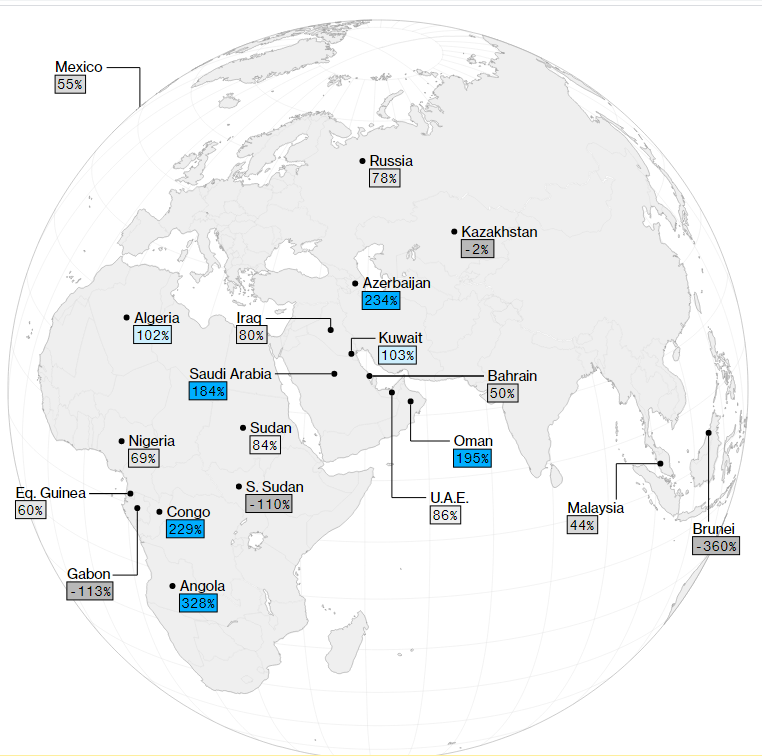 Percentage of cutback target reached
0
20
40
60
80
100
120
140
160
180
U.A.E.
134/156
86%
S. Sudan
-3.289999999999992/3
-110%
Sudan
3.3599999999999994/4
84%
Saudi Arabia
900/489
184%
Oman
66.32000000000005/34
195%
Nigeria
51/74
69%
Malaysia
8.830000000000041/20
44%
Kuwait
144/140
103%
Kazakhstan
-1.1300000000001091/57
-2%
Iraq
152/191
80%
Gabon
-9/8
-113%
Eq. Guinea
3/5
60%
Congo
32/14
229%
Brunei
-14.400000000000006/4
-360%
Bahrain
3.5/7
50%
Azerbaijan
63.299999999999955/27
234%
Angola
154/47
328%
Algeria
45/44
102%
Russia
234.25/300
78%
Mexico
31.720000000000027/58
55%
Note: Positive numbers over 100 indicate full conformity with pledged cuts. A positive number below 100 indicates cuts, but less than pledged. Negative numbers show production actually increased relative to the baseline.
Source: Data compiled by Bloomberg
OPEC+ reset the terms of its agreement as of Jan. 1. Half of the 10 OPEC countries now participating in supply cuts conformed last month, for a rate of 138%, according to Bloomberg calculations from the group’s secondary source data. Non-OPEC adherence was 76%, estimates from preliminary International Energy Agency data on crude supply show. Overall, the OPEC+ coalition had a compliance rate of 119%.
Percentage of cutback target reached
0
20
40
60
80
100
120
140
160
180
U.A.E.
134/156
86%
S. Sudan
-3.289999999999992/3
-110%
Sudan
3.3599999999999994/4
84%
Saudi Arabia
900/489
184%
Oman
66.32000000000005/34
195%
Nigeria
51/74
69%
Malaysia
8.830000000000041/20
44%
Kuwait
144/140
103%
Kazakhstan
-1.1300000000001091/57
-2%
Iraq
152/191
80%
Gabon
-9/8
-113%
Eq. Guinea
3/5
60%
Congo
32/14
229%
Brunei
-14.400000000000006/4
-360%
Bahrain
3.5/7
50%
Azerbaijan
63.299999999999955/27
234%
Angola
154/47
328%
Algeria
45/44
102%
Russia
234.25/300
78%
Mexico
31.720000000000027/58
55%
Note: Positive numbers over 100 indicate full conformity with pledged cuts. A positive number below 100 indicates cuts, but less than pledged. Negative numbers show production actually increased relative to the baseline.
Source: Data compiled by Bloomberg
OPEC+ reset the terms of its agreement as of Jan. 1. Half of the 10 OPEC countries now participating in supply cuts conformed last month, for a rate of 138%, according to Bloomberg calculations from the group’s secondary source data. Non-OPEC adherence was 76%, estimates from preliminary International Energy Agency data on crude supply show. Overall, the OPEC+ coalition had a compliance rate of 119%.

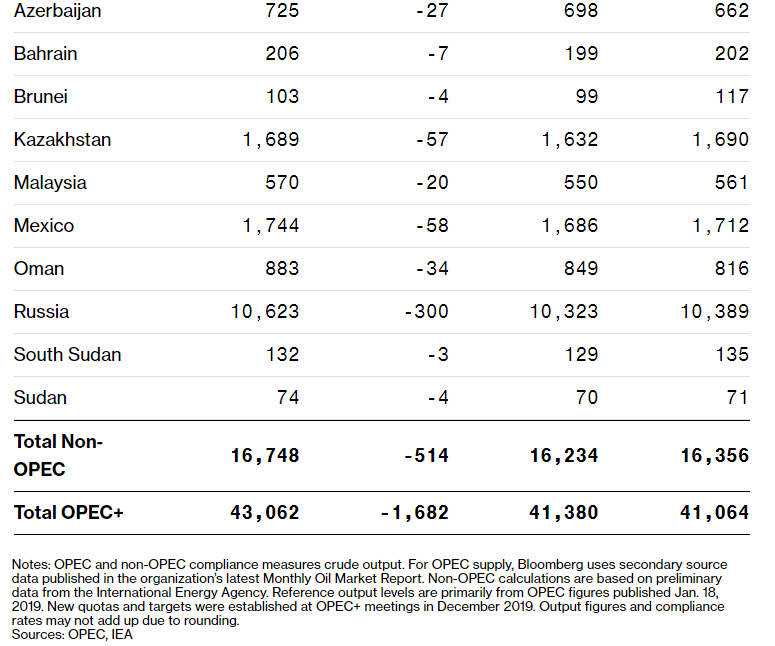 OPEC+ Supply Cuts
Figures are in thousands of barrels a day
OPEC+ Supply Cuts
Figures are in thousands of barrels a day
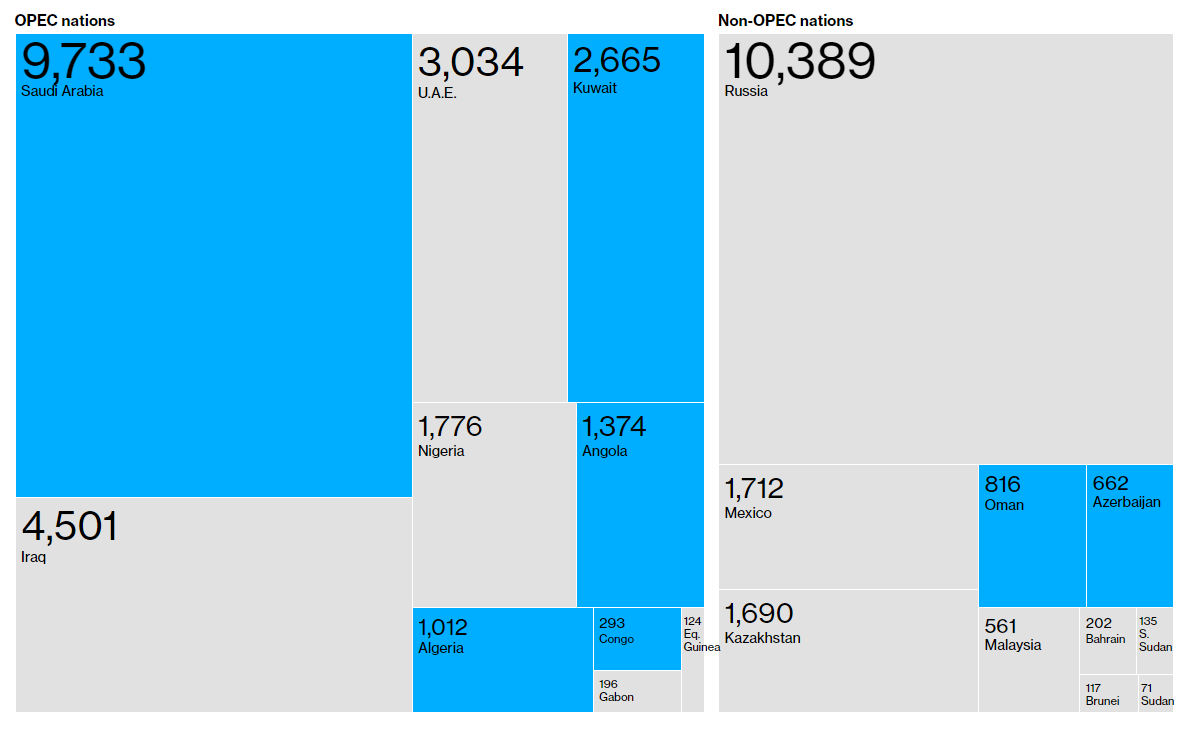 Country
Reference Output
Pledged Cut
Output Target
Jan. 2020
Algeria
1,057
-44
1,013
1,012
Angola
1,528
-47
1,481
1,374
Congo
325
-14
311
293
Eq. Guinea
127
-5
122
124
Gabon
187
-8
179
196
Iraq
4,653
-191
4,462
4,501
Kuwait
2,809
-140
2,669
2,665
Nigeria
1,827
-74
1,753
1,776
Saudi Arabia
10,633
-489
10,144
9,733
U.A.E.
3,168
-156
3,012
3,034
Total OPEC
26,314
-1,168
25,146
24,708
Azerbaijan
725
-27
698
662
Bahrain
206
-7
199
202
Brunei
103
-4
99
117
Kazakhstan
1,689
-57
1,632
1,690
Malaysia
570
-20
550
561
Mexico
1,744
-58
1,686
1,712
Oman
883
-34
849
816
Russia
10,623
-300
10,323
10,389
South Sudan
132
-3
129
135
Sudan
74
-4
70
71
Total Non-OPEC
16,748
-514
16,234
16,356
Total OPEC+
43,062
-1,682
41,380
41,064
Notes: OPEC and non-OPEC compliance measures crude output. For OPEC supply, Bloomberg uses secondary source data published in the organization’s latest Monthly Oil Market Report. Non-OPEC calculations are based on preliminary data from the International Energy Agency. Reference output levels are primarily from OPEC figures published Jan. 18, 2019. New quotas and targets were established at OPEC+ meetings in December 2019. Output figures and compliance rates may not add up due to rounding.
Sources: OPEC, IEA
While the cuts have been in place for more than three years, changes were made in January. The alliance pledged to cut by an additional 500,000 barrels a day at a minimum. In addition, Ecuador left the Organization of Petroleum Exporting Countries, and Russia was able to exclude condensate from its crude production, ostensibly making it easier to meet its target.
Even though a few major OPEC producers failed to comply, Saudi Arabia, Kuwait and Angola helped push the organization safely into full conformity with the revised agreement. Russia, responsible for more than half of the non-OPEC curbs, missed its target for the sixth month in a row. In fact, just two non-OPEC producers conformed: Azerbaijan and Oman. OPEC members Libya, Iran and Venezuela are exempt. Bloomberg estimates for OPEC+ compliance in 2020 include crude production only.
January 2020 Oil Production
Thousands of barrels a day
Country
Reference Output
Pledged Cut
Output Target
Jan. 2020
Algeria
1,057
-44
1,013
1,012
Angola
1,528
-47
1,481
1,374
Congo
325
-14
311
293
Eq. Guinea
127
-5
122
124
Gabon
187
-8
179
196
Iraq
4,653
-191
4,462
4,501
Kuwait
2,809
-140
2,669
2,665
Nigeria
1,827
-74
1,753
1,776
Saudi Arabia
10,633
-489
10,144
9,733
U.A.E.
3,168
-156
3,012
3,034
Total OPEC
26,314
-1,168
25,146
24,708
Azerbaijan
725
-27
698
662
Bahrain
206
-7
199
202
Brunei
103
-4
99
117
Kazakhstan
1,689
-57
1,632
1,690
Malaysia
570
-20
550
561
Mexico
1,744
-58
1,686
1,712
Oman
883
-34
849
816
Russia
10,623
-300
10,323
10,389
South Sudan
132
-3
129
135
Sudan
74
-4
70
71
Total Non-OPEC
16,748
-514
16,234
16,356
Total OPEC+
43,062
-1,682
41,380
41,064
Notes: OPEC and non-OPEC compliance measures crude output. For OPEC supply, Bloomberg uses secondary source data published in the organization’s latest Monthly Oil Market Report. Non-OPEC calculations are based on preliminary data from the International Energy Agency. Reference output levels are primarily from OPEC figures published Jan. 18, 2019. New quotas and targets were established at OPEC+ meetings in December 2019. Output figures and compliance rates may not add up due to rounding.
Sources: OPEC, IEA
While the cuts have been in place for more than three years, changes were made in January. The alliance pledged to cut by an additional 500,000 barrels a day at a minimum. In addition, Ecuador left the Organization of Petroleum Exporting Countries, and Russia was able to exclude condensate from its crude production, ostensibly making it easier to meet its target.
Even though a few major OPEC producers failed to comply, Saudi Arabia, Kuwait and Angola helped push the organization safely into full conformity with the revised agreement. Russia, responsible for more than half of the non-OPEC curbs, missed its target for the sixth month in a row. In fact, just two non-OPEC producers conformed: Azerbaijan and Oman. OPEC members Libya, Iran and Venezuela are exempt. Bloomberg estimates for OPEC+ compliance in 2020 include crude production only.
January 2020 Oil Production
Thousands of barrels a day
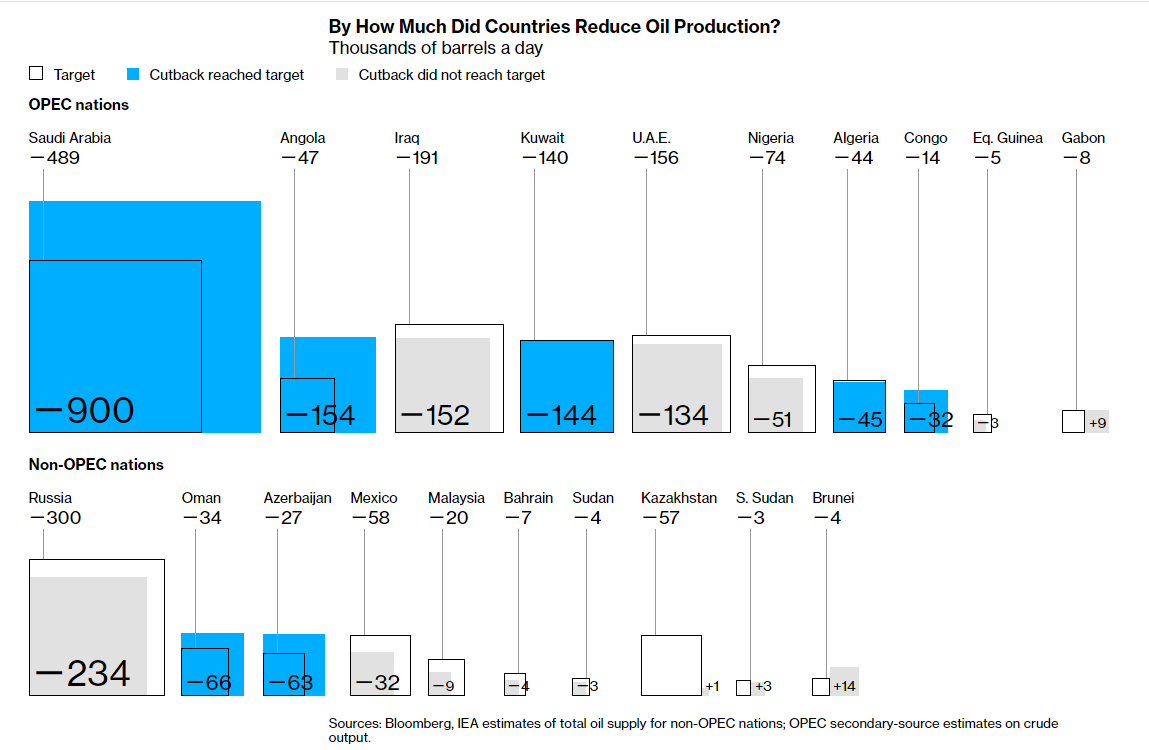 Cutback reached target Cutback did not reach target
OPEC nations
9,733
Saudi Arabia
4,501
Iraq
3,034
U.A.E.
2,665
Kuwait
1,776
Nigeria
1,374
Angola
1,012
Algeria
293
Congo
196
Gabon
124
Eq. Guinea
Non-OPEC nations
10,389
Russia
1,712
Mexico
1,690
Kazakhstan
816
Oman
662
Azerbaijan
561
Malaysia
202
Bahrain
135
S. Sudan
117
Brunei
71
Sudan
Sources: OPEC secondary-source estimates of crude output for organization’s members. IEA preliminary estimates of crude supply, excluding condensates, for non-OPEC members.
Saudi Arabia agreed to curb by an extra 400,000 barrels a day beyond its pledged cut of 489,000 if others—notably Iraq—also deepened their curbs. In January, the kingdom slashed supply by an average 900,000 barrels daily, though Iraq still failed to reach its target. However, the extra Saudi effort is hardly new: the country exceeded its required cut by at least 400,000 barrels a day in all but three months last year. Bloomberg measures OPEC compliance without the voluntary Saudi curb.
By How Much Did Countries Reduce Oil Production?
Thousands of barrels a day
Target Cutback reached target Cutback did not reach target
OPEC nations
Saudi Arabia
−489
−900
Angola
−47
−154
Iraq
−191
−152
Kuwait
−140
−144
U.A.E.
−156
−134
Nigeria
−74
−51
Algeria
−44
−45
Congo
−14
−32
Eq. Guinea
−5
−3
Gabon
−8
+9
Non-OPEC nations
Russia
−300
−234
Oman
−34
−66
Azerbaijan
−27
−63
Mexico
−58
−32
Malaysia
−20
−9
Bahrain
−7
−4
Sudan
−4
−3
Kazakhstan
−57
+1
S. Sudan
−3
+3
Brunei
−4
+14
Sources: Bloomberg, IEA estimates of total oil supply for non-OPEC nations; OPEC secondary-source estimates on crude output.
In recent years, OPEC+ has been forced to contend with rising American production and a trade war between the U.S. and China, both of which weighed on crude prices. Now there’s a third threat: the coronavirus outbreak, which has killed thousands in China while bringing the country to a halt. Chinese demand for oil products is likely to plunge by more than 35% year-on-year in the first quarter, Morgan Stanley said in a recent report, citing data from researchers at China oil giant CNPC.
Cutback reached target Cutback did not reach target
OPEC nations
9,733
Saudi Arabia
4,501
Iraq
3,034
U.A.E.
2,665
Kuwait
1,776
Nigeria
1,374
Angola
1,012
Algeria
293
Congo
196
Gabon
124
Eq. Guinea
Non-OPEC nations
10,389
Russia
1,712
Mexico
1,690
Kazakhstan
816
Oman
662
Azerbaijan
561
Malaysia
202
Bahrain
135
S. Sudan
117
Brunei
71
Sudan
Sources: OPEC secondary-source estimates of crude output for organization’s members. IEA preliminary estimates of crude supply, excluding condensates, for non-OPEC members.
Saudi Arabia agreed to curb by an extra 400,000 barrels a day beyond its pledged cut of 489,000 if others—notably Iraq—also deepened their curbs. In January, the kingdom slashed supply by an average 900,000 barrels daily, though Iraq still failed to reach its target. However, the extra Saudi effort is hardly new: the country exceeded its required cut by at least 400,000 barrels a day in all but three months last year. Bloomberg measures OPEC compliance without the voluntary Saudi curb.
By How Much Did Countries Reduce Oil Production?
Thousands of barrels a day
Target Cutback reached target Cutback did not reach target
OPEC nations
Saudi Arabia
−489
−900
Angola
−47
−154
Iraq
−191
−152
Kuwait
−140
−144
U.A.E.
−156
−134
Nigeria
−74
−51
Algeria
−44
−45
Congo
−14
−32
Eq. Guinea
−5
−3
Gabon
−8
+9
Non-OPEC nations
Russia
−300
−234
Oman
−34
−66
Azerbaijan
−27
−63
Mexico
−58
−32
Malaysia
−20
−9
Bahrain
−7
−4
Sudan
−4
−3
Kazakhstan
−57
+1
S. Sudan
−3
+3
Brunei
−4
+14
Sources: Bloomberg, IEA estimates of total oil supply for non-OPEC nations; OPEC secondary-source estimates on crude output.
In recent years, OPEC+ has been forced to contend with rising American production and a trade war between the U.S. and China, both of which weighed on crude prices. Now there’s a third threat: the coronavirus outbreak, which has killed thousands in China while bringing the country to a halt. Chinese demand for oil products is likely to plunge by more than 35% year-on-year in the first quarter, Morgan Stanley said in a recent report, citing data from researchers at China oil giant CNPC.
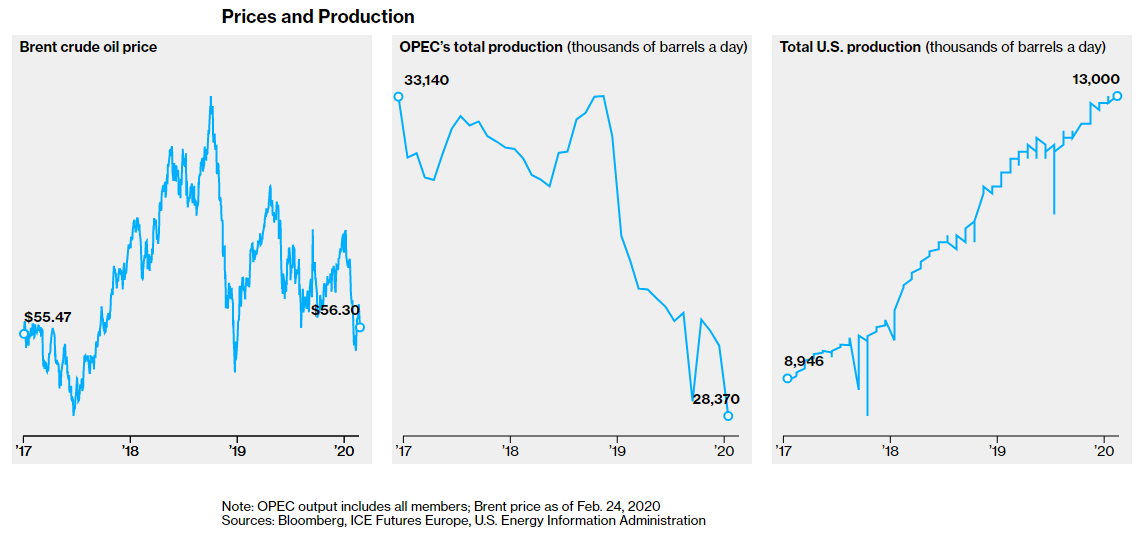 Note: OPEC output includes all members; Brent price as of Feb. 24, 2020
Sources: Bloomberg, ICE Futures Europe, U.S. Energy Information Administration
The next OPEC+ gathering, on March 5-6 in Vienna, is among the most anticipated in years. For weeks, there was speculation that the coalition’s ministers would hold an emergency meeting to address the coronavirus threat. Such a gathering never happened. In addition, Russia, one of the two powerhouses behind the pact, has increasingly seemed to distance itself from the group—if compliance is anything to judge by.
Source: Data compiled by Bloomberg
With assistance from: Ronan Martin and Grant Smith
Additional work by: Brittany Harris
Editor: Alaric Nightingale
Note: OPEC output includes all members; Brent price as of Feb. 24, 2020
Sources: Bloomberg, ICE Futures Europe, U.S. Energy Information Administration
The next OPEC+ gathering, on March 5-6 in Vienna, is among the most anticipated in years. For weeks, there was speculation that the coalition’s ministers would hold an emergency meeting to address the coronavirus threat. Such a gathering never happened. In addition, Russia, one of the two powerhouses behind the pact, has increasingly seemed to distance itself from the group—if compliance is anything to judge by.
Source: Data compiled by Bloomberg
With assistance from: Ronan Martin and Grant Smith
Additional work by: Brittany Harris
Editor: Alaric Nightingale